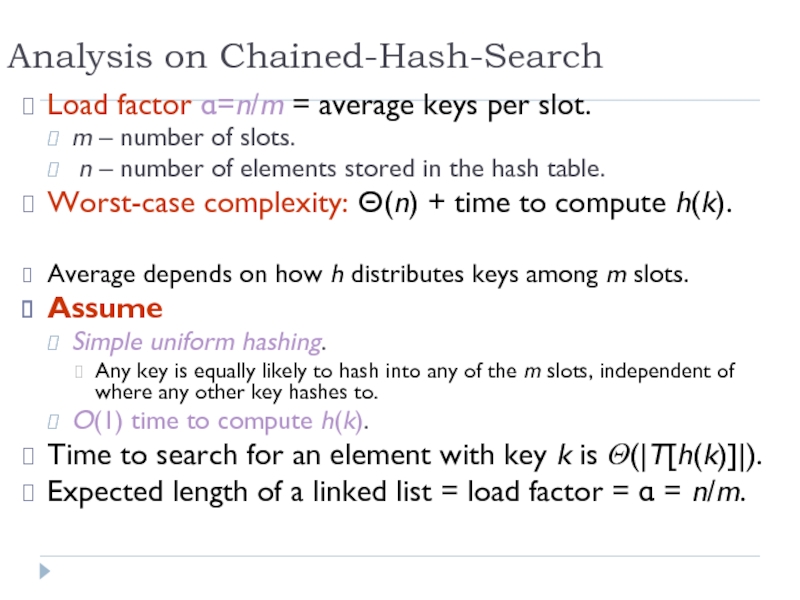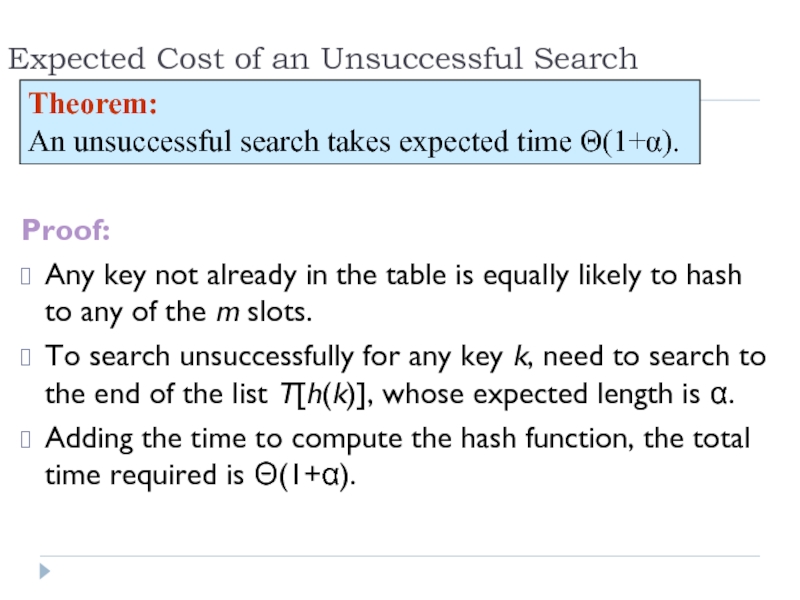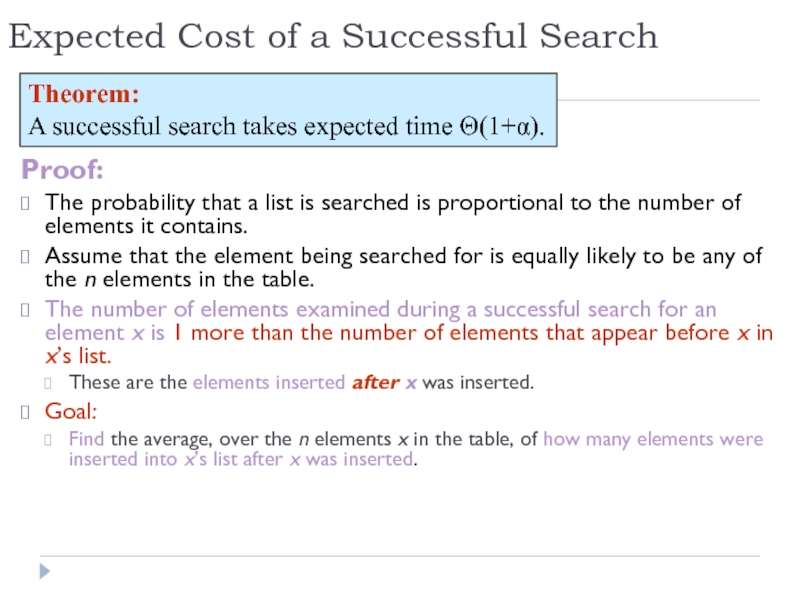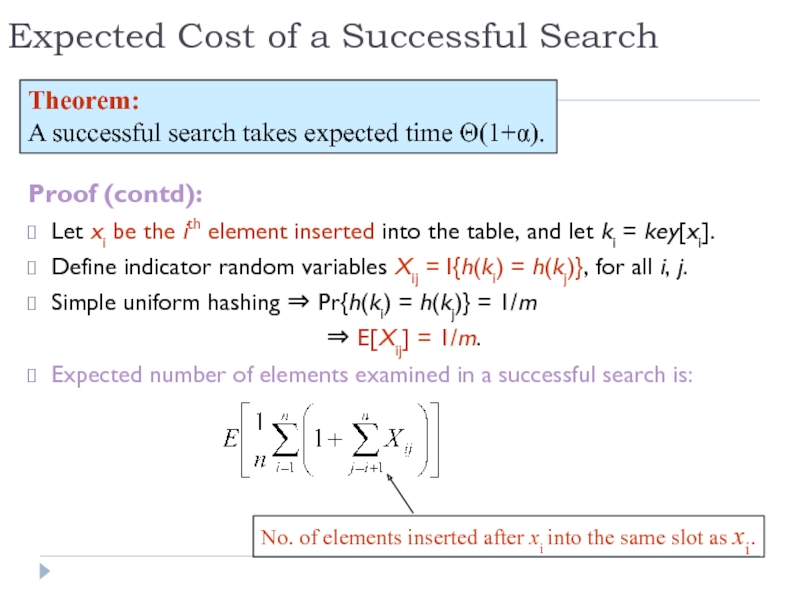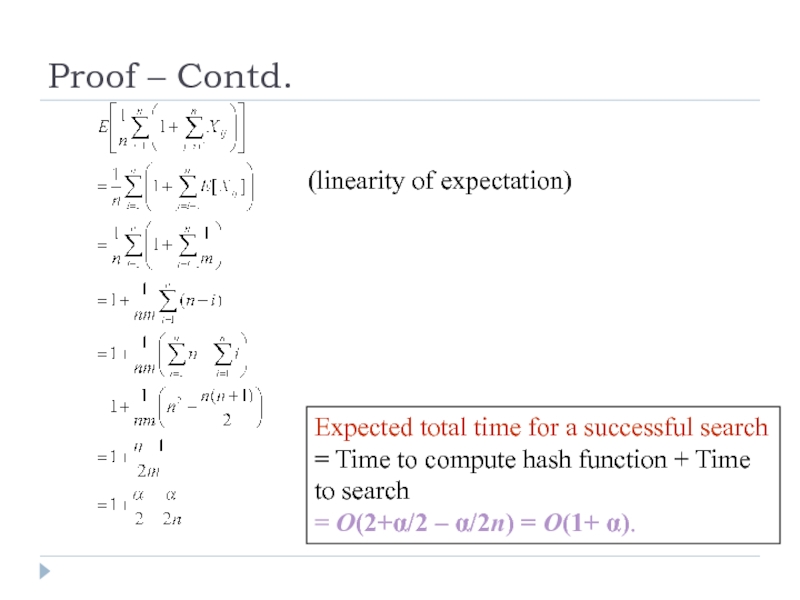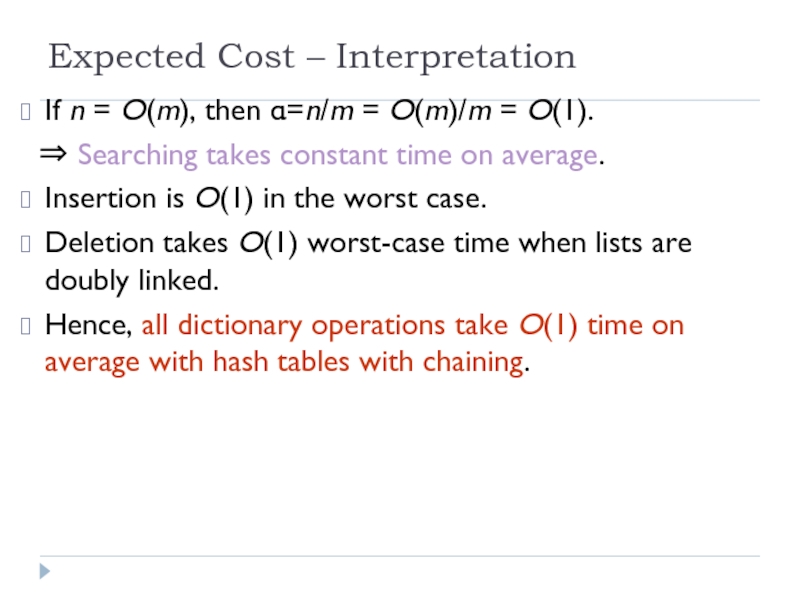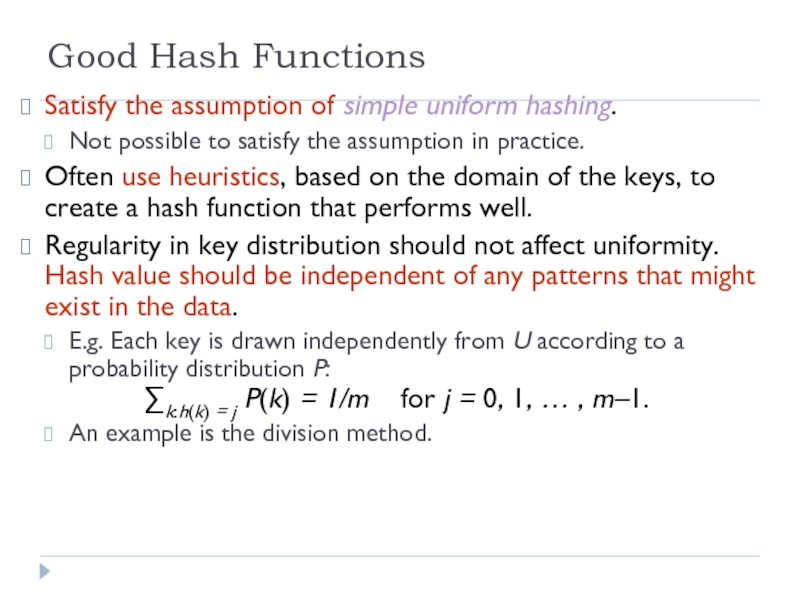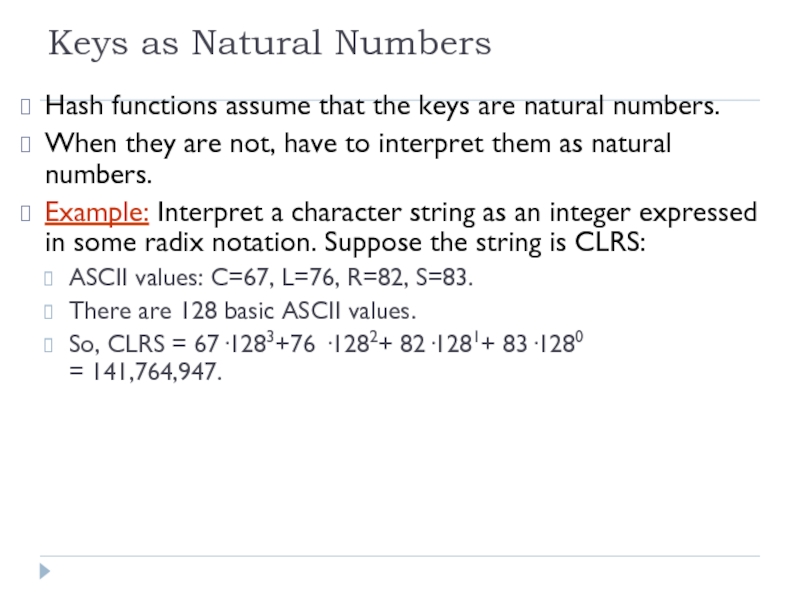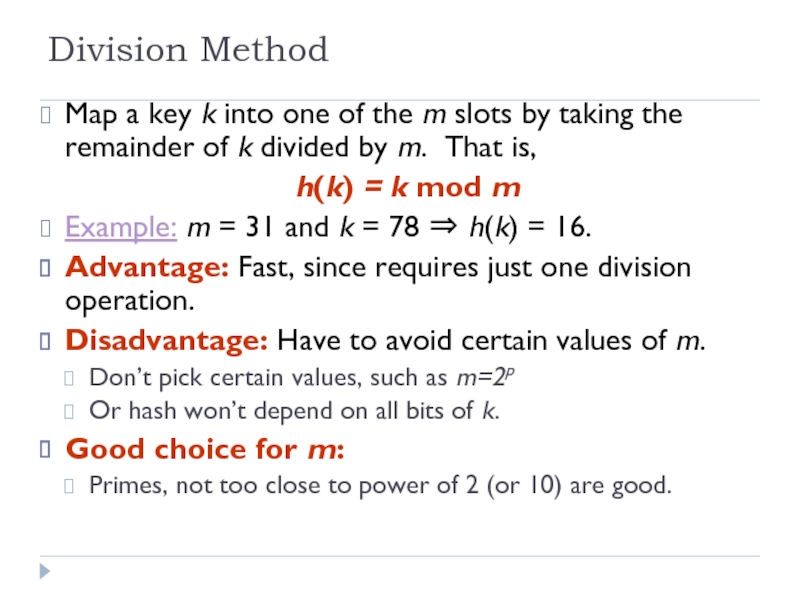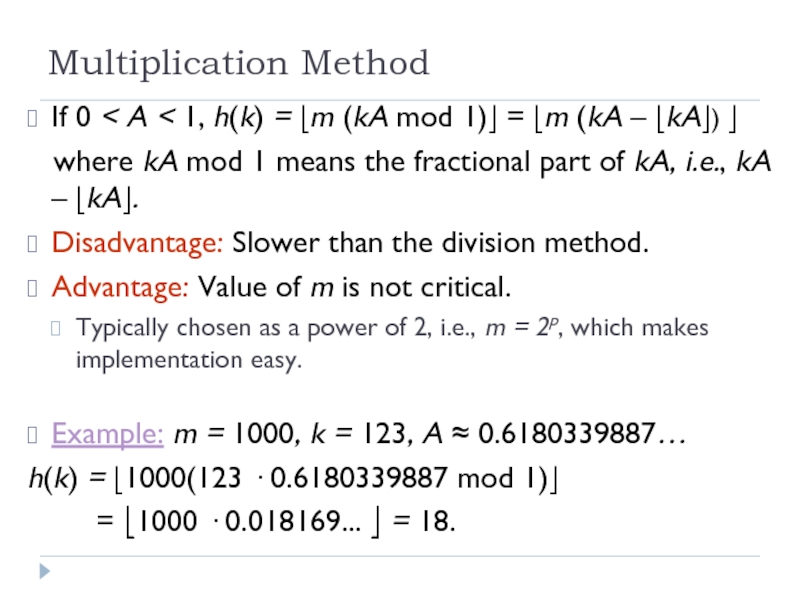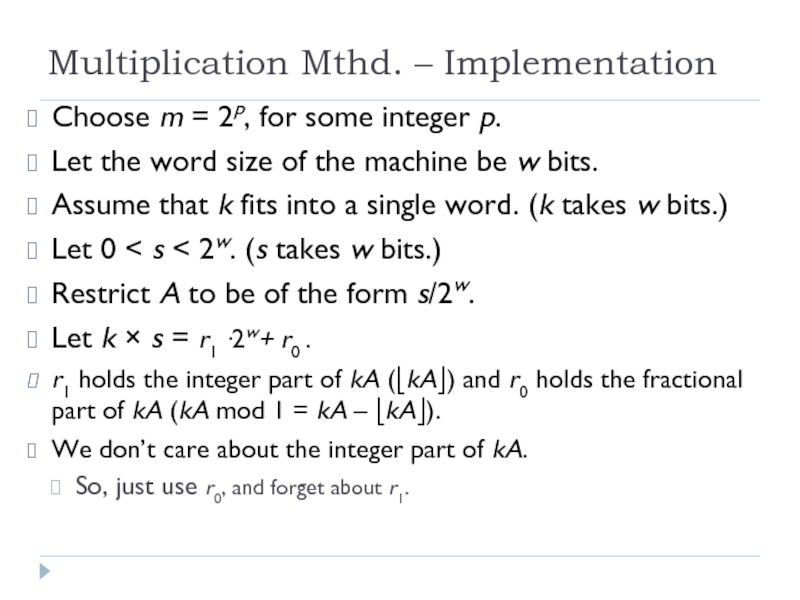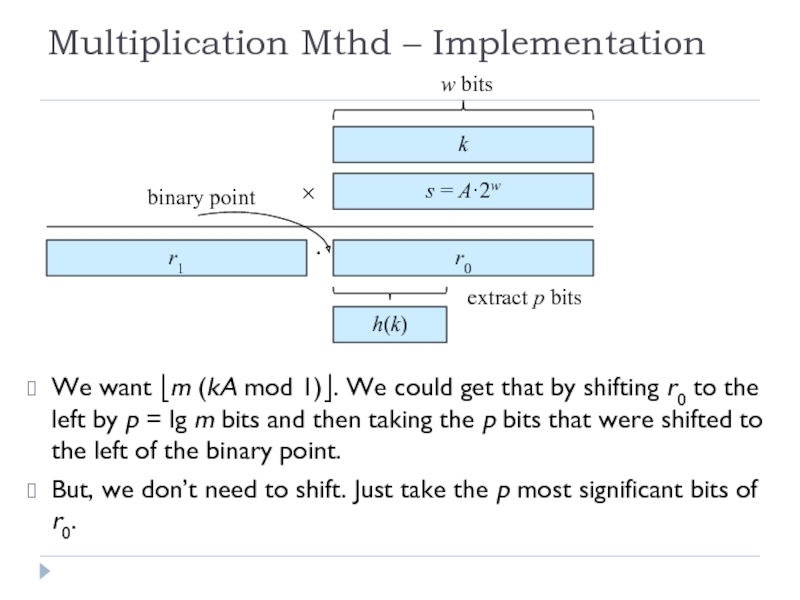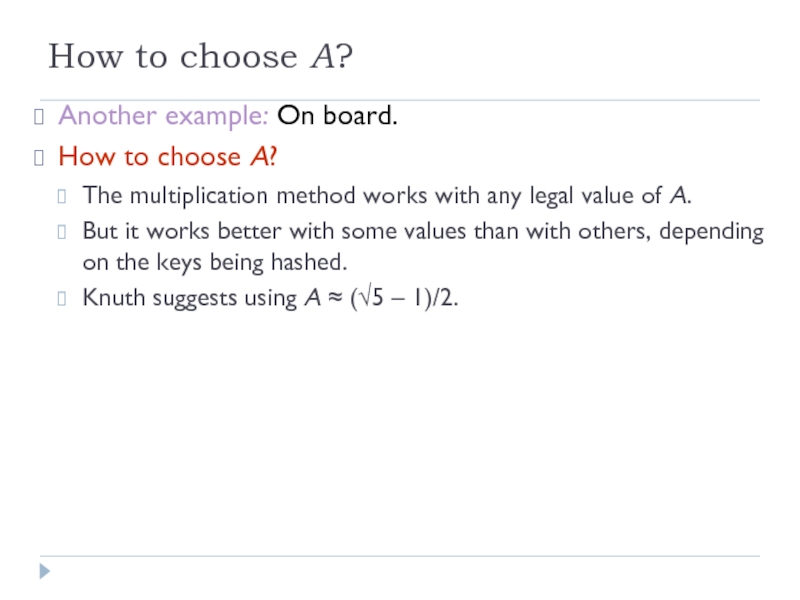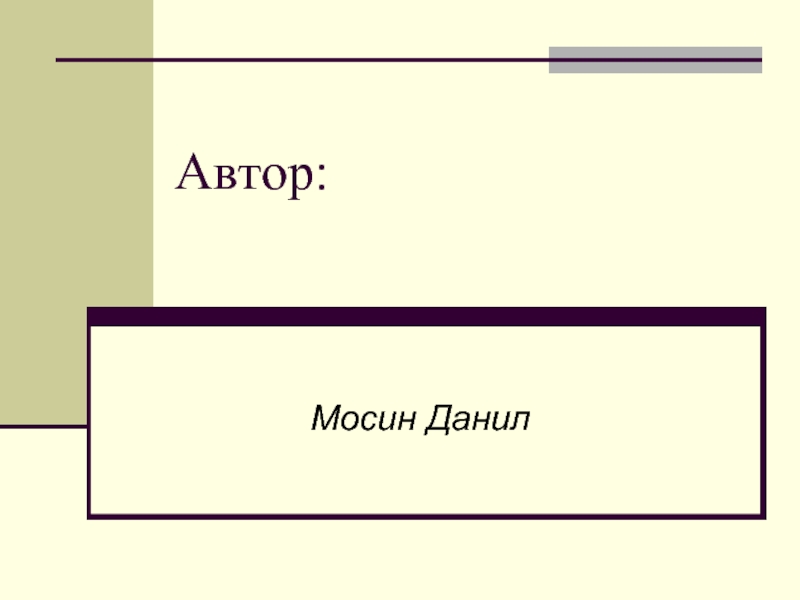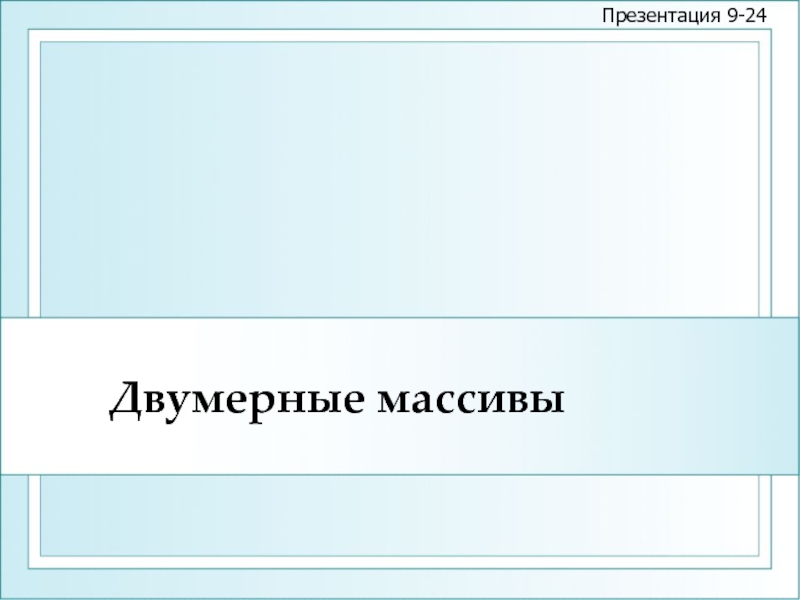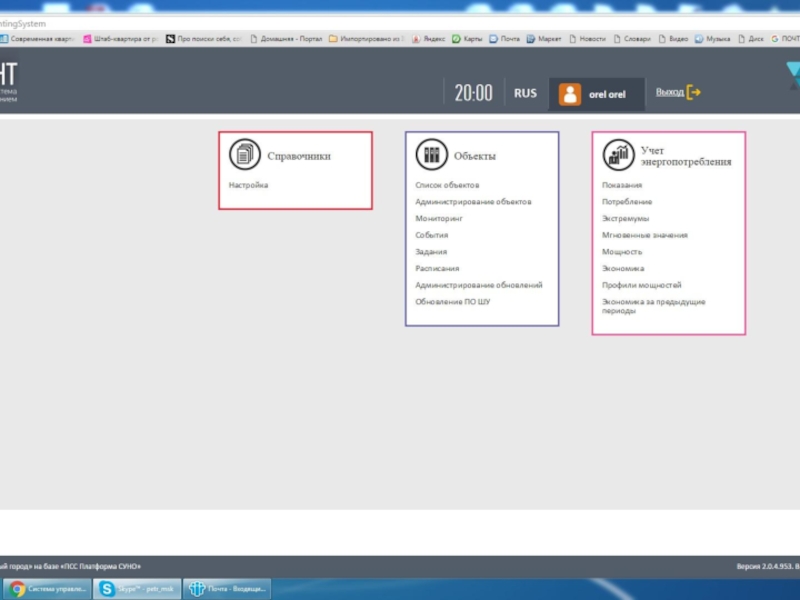- Главная
- Разное
- Дизайн
- Бизнес и предпринимательство
- Аналитика
- Образование
- Развлечения
- Красота и здоровье
- Финансы
- Государство
- Путешествия
- Спорт
- Недвижимость
- Армия
- Графика
- Культурология
- Еда и кулинария
- Лингвистика
- Английский язык
- Астрономия
- Алгебра
- Биология
- География
- Детские презентации
- Информатика
- История
- Литература
- Маркетинг
- Математика
- Медицина
- Менеджмент
- Музыка
- МХК
- Немецкий язык
- ОБЖ
- Обществознание
- Окружающий мир
- Педагогика
- Русский язык
- Технология
- Физика
- Философия
- Химия
- Шаблоны, картинки для презентаций
- Экология
- Экономика
- Юриспруденция
Hash Tables презентация
Содержание
- 1. Hash Tables
- 2. Dictionary Dictionary: Dynamic-set data structure for
- 3. Direct-address Tables Direct-address Tables are ordinary
- 4. Hash Tables Notation: U – Universe of
- 5. Hashing Hash function h: Mapping from U
- 6. Hashing 0 m–1 h(k1) h(k4) h(k2)=h(k5)
- 7. Issues with Hashing Multiple keys can hash
- 8. Methods of Resolution Chaining: Store all
- 9. Collision Resolution by Chaining 0 m–1
- 10. Collision Resolution by Chaining k2 0
- 11. Hashing with Chaining Dictionary Operations: Chained-Hash-Insert (T,
- 12. Analysis on Chained-Hash-Search Load factor α=n/m =
- 13. Expected Cost of an Unsuccessful Search Proof:
- 14. Expected Cost of a Successful Search Proof:
- 15. Expected Cost of a Successful Search Proof
- 16. Proof – Contd. (linearity of expectation) Expected
- 17. Expected Cost – Interpretation If n =
- 18. Good Hash Functions Satisfy the assumption of
- 19. Keys as Natural Numbers Hash functions assume
- 20. Division Method Map a key k into
- 21. Multiplication Method If 0 < A <
- 22. Multiplication Mthd. – Implementation Choose m =
- 23. Multiplication Mthd – Implementation We want ⎣m
- 24. How to choose A? Another example: On
Слайд 2Dictionary
Dictionary:
Dynamic-set data structure for storing items indexed using keys.
Supports operations
Applications:
Symbol table of a compiler.
Memory-management tables in operating systems.
Large-scale distributed systems.
Hash Tables:
Effective way of implementing dictionaries.
Generalization of ordinary arrays.
Слайд 3Direct-address Tables
Direct-address Tables are ordinary arrays.
Facilitate direct addressing.
Element whose key
Applicable when we can afford to allocate an array with one position for every possible key.
i.e. when the universe of keys U is small.
Dictionary operations can be implemented to take O(1) time.
Details in Sec. 11.1.
Слайд 4Hash Tables
Notation:
U – Universe of all possible keys.
K – Set of
|K| = n.
When U is very large,
Arrays are not practical.
|K| << |U|.
Use a table of size proportional to |K| – The hash tables.
However, we lose the direct-addressing ability.
Define functions that map keys to slots of the hash table.
Слайд 5Hashing
Hash function h: Mapping from U to the slots of a
h : U → {0,1,…, m–1}
With arrays, key k maps to slot A[k].
With hash tables, key k maps or “hashes” to slot T[h[k]].
h[k] is the hash value of key k.
Слайд 7Issues with Hashing
Multiple keys can hash to the same slot –
Design hash functions such that collisions are minimized.
But avoiding collisions is impossible.
Design collision-resolution techniques.
Search will cost Ө(n) time in the worst case.
However, all operations can be made to have an expected complexity of Ө(1).
Слайд 8Methods of Resolution
Chaining:
Store all elements that hash to the same
Store a pointer to the head of the linked list in the hash table slot.
Open Addressing:
All elements stored in hash table itself.
When collisions occur, use a systematic (consistent) procedure to store elements in free slots of the table.
k2
0
m–1
k1
k4
k5
k6
k7
k3
k8
Слайд 9Collision Resolution by Chaining
0
m–1
h(k1)=h(k4)
h(k2)=h(k5)=h(k6)
h(k3)=h(k7)
U
(universe of keys)
K
(actual
keys)
k1
k2
k3
k5
k4
k6
k7
k8
h(k8)
X
X
X
Слайд 10Collision Resolution by Chaining
k2
0
m–1
U
(universe of keys)
K
(actual
keys)
k1
k2
k3
k5
k4
k6
k7
k8
k1
k4
k5
k6
k7
k3
k8
Слайд 11Hashing with Chaining
Dictionary Operations:
Chained-Hash-Insert (T, x)
Insert x at the head of
Worst-case complexity – O(1).
Chained-Hash-Delete (T, x)
Delete x from the list T[h(key[x])].
Worst-case complexity – proportional to length of list with singly-linked lists. O(1) with doubly-linked lists.
Chained-Hash-Search (T, k)
Search an element with key k in list T[h(k)].
Worst-case complexity – proportional to length of list.
Слайд 12Analysis on Chained-Hash-Search
Load factor α=n/m = average keys per slot.
m –
n – number of elements stored in the hash table.
Worst-case complexity: Θ(n) + time to compute h(k).
Average depends on how h distributes keys among m slots.
Assume
Simple uniform hashing.
Any key is equally likely to hash into any of the m slots, independent of where any other key hashes to.
O(1) time to compute h(k).
Time to search for an element with key k is Θ(|T[h(k)]|).
Expected length of a linked list = load factor = α = n/m.
Слайд 13Expected Cost of an Unsuccessful Search
Proof:
Any key not already in the
To search unsuccessfully for any key k, need to search to the end of the list T[h(k)], whose expected length is α.
Adding the time to compute the hash function, the total time required is Θ(1+α).
Theorem:
An unsuccessful search takes expected time Θ(1+α).
Слайд 14Expected Cost of a Successful Search
Proof:
The probability that a list is
Assume that the element being searched for is equally likely to be any of the n elements in the table.
The number of elements examined during a successful search for an element x is 1 more than the number of elements that appear before x in x’s list.
These are the elements inserted after x was inserted.
Goal:
Find the average, over the n elements x in the table, of how many elements were inserted into x’s list after x was inserted.
Theorem:
A successful search takes expected time Θ(1+α).
Слайд 15Expected Cost of a Successful Search
Proof (contd):
Let xi be the ith
Define indicator random variables Xij = I{h(ki) = h(kj)}, for all i, j.
Simple uniform hashing ⇒ Pr{h(ki) = h(kj)} = 1/m
⇒ E[Xij] = 1/m.
Expected number of elements examined in a successful search is:
Theorem:
A successful search takes expected time Θ(1+α).
No. of elements inserted after xi into the same slot as xi.
Слайд 16Proof – Contd.
(linearity of expectation)
Expected total time for a successful search
= O(2+α/2 – α/2n) = O(1+ α).
Слайд 17Expected Cost – Interpretation
If n = O(m), then α=n/m = O(m)/m
⇒ Searching takes constant time on average.
Insertion is O(1) in the worst case.
Deletion takes O(1) worst-case time when lists are doubly linked.
Hence, all dictionary operations take O(1) time on average with hash tables with chaining.
Слайд 18Good Hash Functions
Satisfy the assumption of simple uniform hashing.
Not possible to
Often use heuristics, based on the domain of the keys, to create a hash function that performs well.
Regularity in key distribution should not affect uniformity. Hash value should be independent of any patterns that might exist in the data.
E.g. Each key is drawn independently from U according to a probability distribution P:
∑k:h(k) = j P(k) = 1/m for j = 0, 1, … , m–1.
An example is the division method.
Слайд 19Keys as Natural Numbers
Hash functions assume that the keys are natural
When they are not, have to interpret them as natural numbers.
Example: Interpret a character string as an integer expressed in some radix notation. Suppose the string is CLRS:
ASCII values: C=67, L=76, R=82, S=83.
There are 128 basic ASCII values.
So, CLRS = 67·1283+76 ·1282+ 82·1281+ 83·1280 = 141,764,947.
Слайд 20Division Method
Map a key k into one of the m slots
h(k) = k mod m
Example: m = 31 and k = 78 ⇒ h(k) = 16.
Advantage: Fast, since requires just one division operation.
Disadvantage: Have to avoid certain values of m.
Don’t pick certain values, such as m=2p
Or hash won’t depend on all bits of k.
Good choice for m:
Primes, not too close to power of 2 (or 10) are good.
Слайд 21Multiplication Method
If 0 < A < 1, h(k) = ⎣m (kA
where kA mod 1 means the fractional part of kA, i.e., kA – ⎣kA⎦.
Disadvantage: Slower than the division method.
Advantage: Value of m is not critical.
Typically chosen as a power of 2, i.e., m = 2p, which makes implementation easy.
Example: m = 1000, k = 123, A ≈ 0.6180339887…
h(k) = ⎣1000(123 · 0.6180339887 mod 1)⎦
= ⎣1000 · 0.018169... ⎦ = 18.
Слайд 22Multiplication Mthd. – Implementation
Choose m = 2p, for some integer p.
Let
Assume that k fits into a single word. (k takes w bits.)
Let 0 < s < 2w. (s takes w bits.)
Restrict A to be of the form s/2w.
Let k × s = r1 ·2w+ r0 .
r1 holds the integer part of kA (⎣kA⎦) and r0 holds the fractional part of kA (kA mod 1 = kA – ⎣kA⎦).
We don’t care about the integer part of kA.
So, just use r0, and forget about r1.
Слайд 23Multiplication Mthd – Implementation
We want ⎣m (kA mod 1)⎦. We could
But, we don’t need to shift. Just take the p most significant bits of r0.
k
s = A·2w
r0
r1
w bits
×
h(k)
extract p bits
·
binary point
Слайд 24How to choose A?
Another example: On board.
How to choose A?
The multiplication
But it works better with some values than with others, depending on the keys being hashed.
Knuth suggests using A ≈ (√5 – 1)/2.

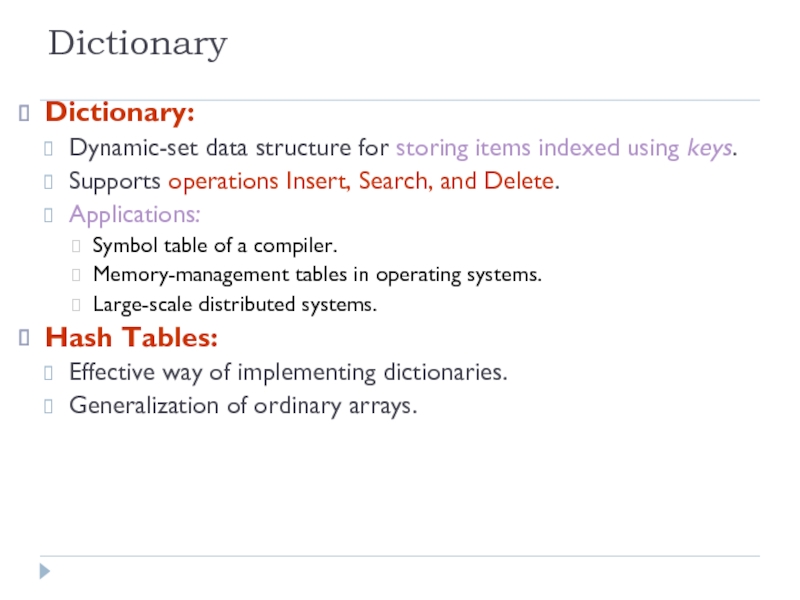
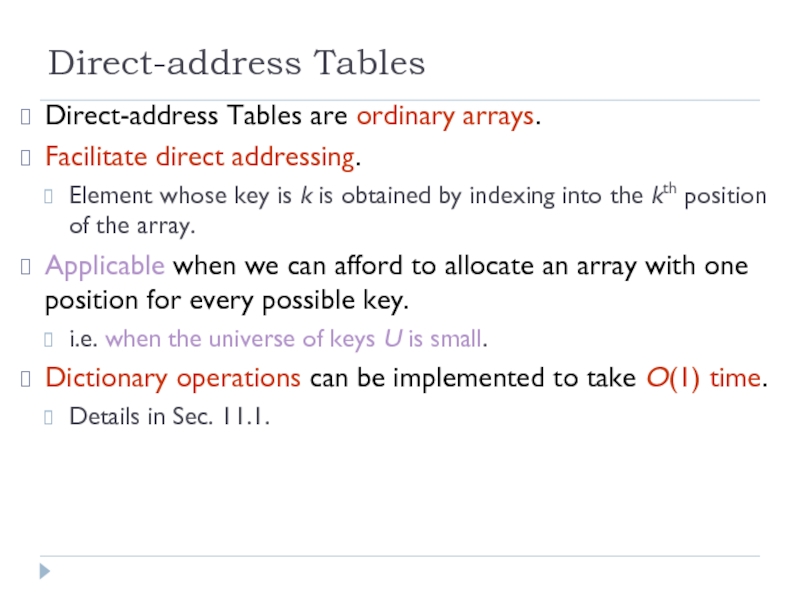
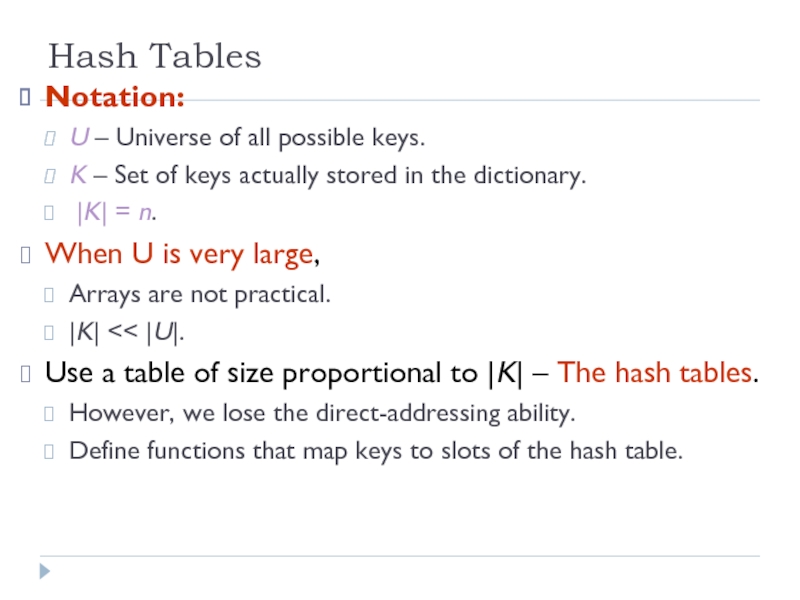
![HashingHash function h: Mapping from U to the slots of a hash table T[0..m–1].](/img/tmb/5/443929/35b5b4d3d15e97cd5983987e7d854330-800x.jpg)
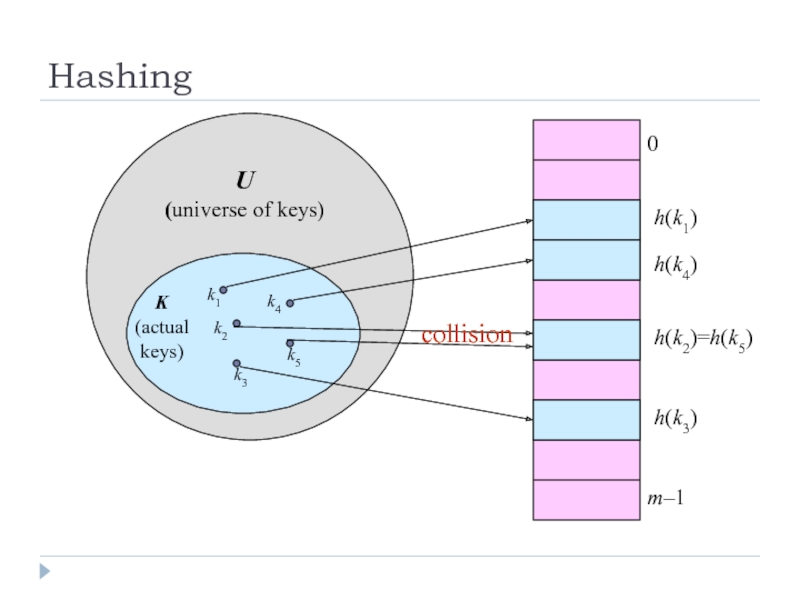
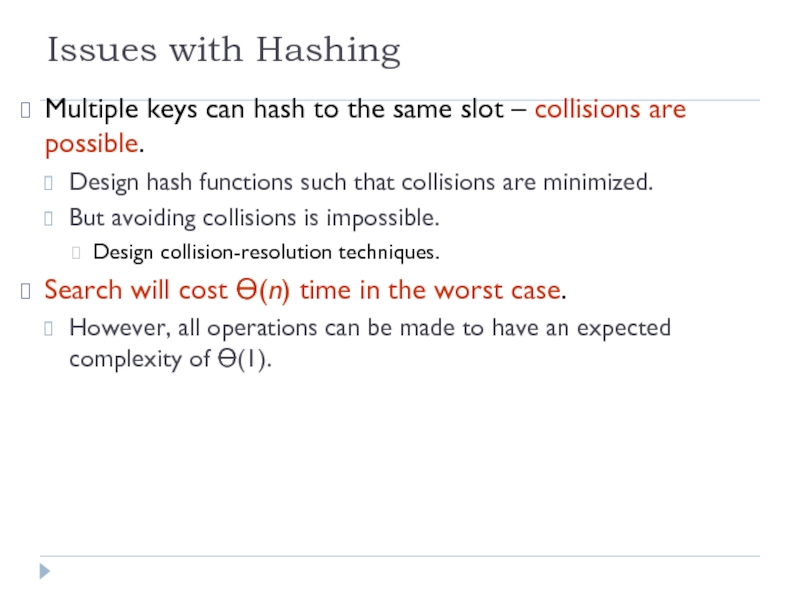
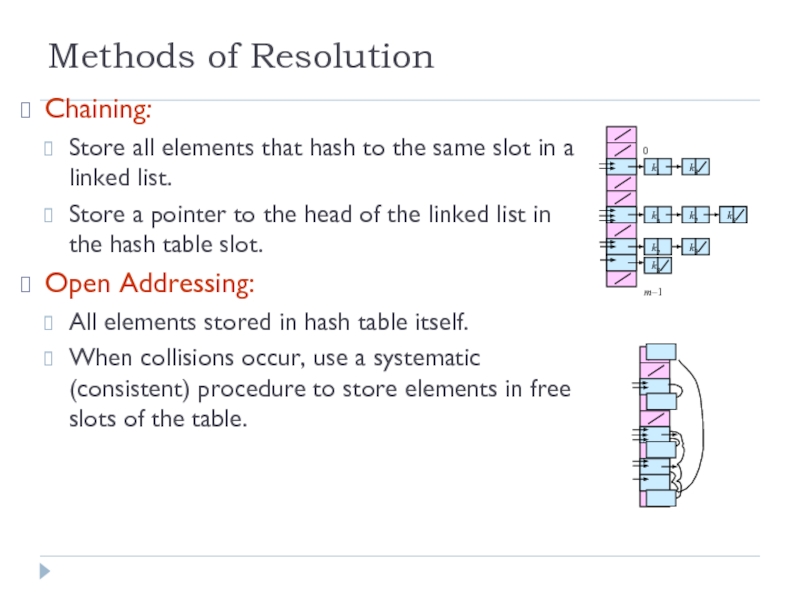
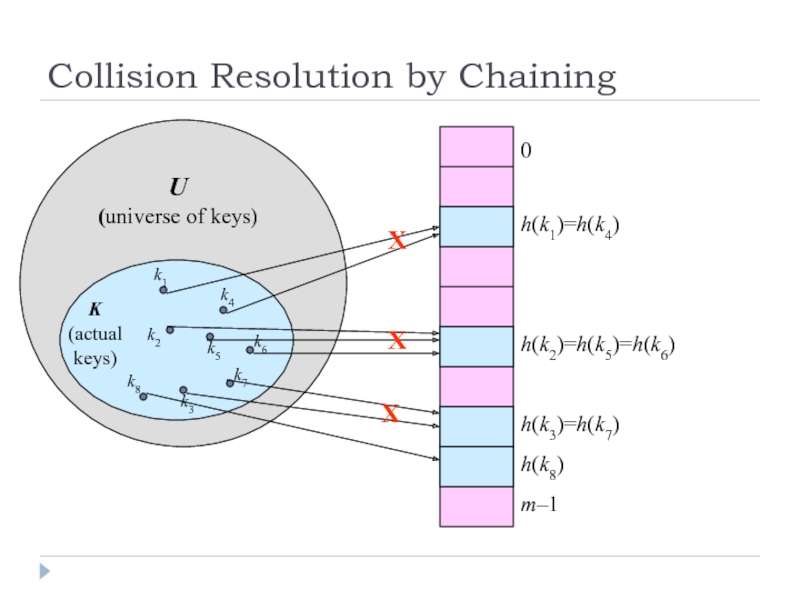
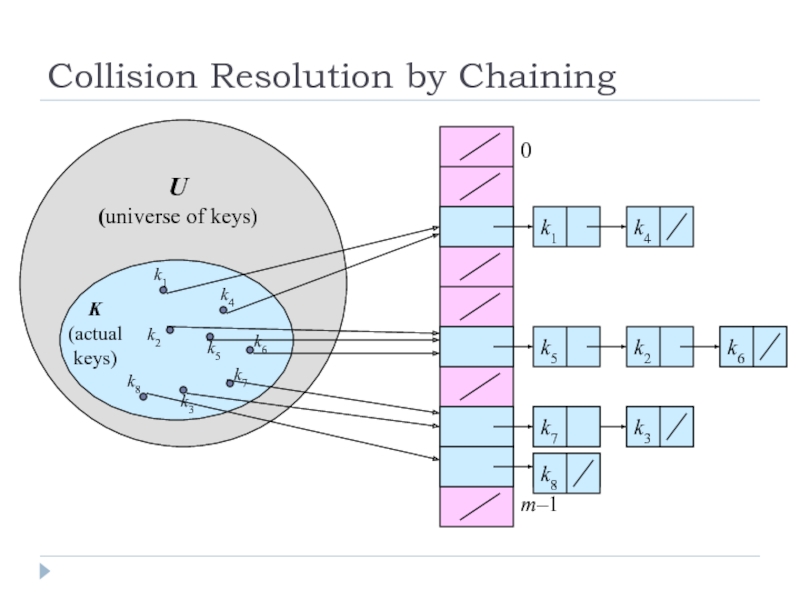
![Hashing with ChainingDictionary Operations:Chained-Hash-Insert (T, x)Insert x at the head of list T[h(key[x])].Worst-case complexity –](/img/tmb/5/443929/77bcf0e51652aa7349ed952dd4b1a747-800x.jpg)
